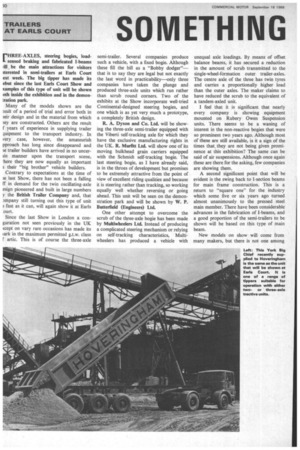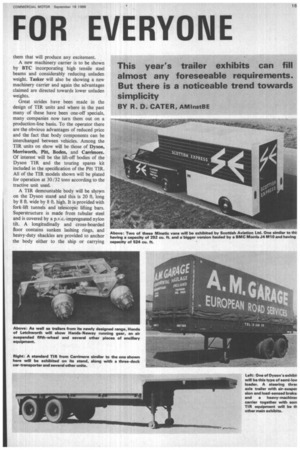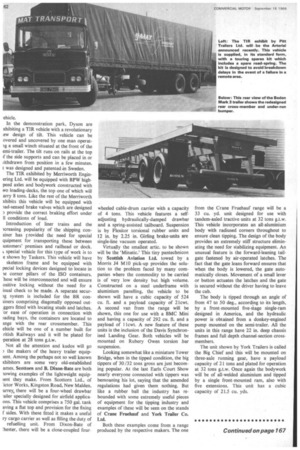SOMETHING FOR EVERYONE
Page 158

Page 159

Page 160

Page 165

If you've noticed an error in this article please click here to report it so we can fix it.
rHREE-AXLES, steering bogies, load
sensed braking and fabricated 1-beams nil be the main attractions for visitors nerested in semi-trailers at Earls Court ext week. The big tipper has made its ebut since the last Earls Court Show and xamples of this type of unit will be shown oth inside the exhibition and in the demontration park.
Many of the models shown are the ;stilt of a period of trial and error both in leir design and in the material from which ley are constructed. Others are the result f years of experience in supplying trailer quipment to the transport industry. In very case, however, the amateurish pproach has long since disappeared and le trailer builders have arrived in no uncertin manner upon the transport scene, here they are now equally as important s their "big brother" vehicle builders. Contrary to expectations at the time of le last Show, there has not been a falling If in demand for the twin oscillating-axle esign pioneered and built in large numbers y the British Trailer Company and, that 3mpany still turning out this type of unit 3 fast as it can, will again show it at Earls ourt.
Since the last Show in London a conguration not seen previously in the UK ccept on vary rare occasions has made its lark in the maximum permitted g.t.w. class f artic. This is of course the three-axle semi-trailer. Several companies produce such a vehicle, with a fixed bogie. Although these fill the bill as a "Bobby dodger"— that is to say they are legal but not exactly the last word in practicability—only three companies have taken the plunge and produced three-axle units which run rather than scrub round corners. Two of the exhibits at the Show incorporate well-tried Continental-designed steering bogies, and one which is as yet very much a prototype, a completely British design.
R. A. Dyson and Co. Ltd. will be showing the three-axle semi-trailer equipped with the Viberti self-tracking axle for which they have the exclusive manufacturing rights in the UK. R. Murfitt Ltd. will show one of its moving bulkhead grain carriers equipped with the Schmidt self-tracking bogie. The last steering bogie, as I have already said, is in the throes of development but promises to be extremely attractive from the point of view of excellent riding qualities and because it is steering rather than tracking, so working equally well whether reversing or going ahead. This unit will be seen on the demonstration park and will be shown by W. P. Butterfield (Engineers) Ltd.
One other attempt to overcome the scrub of the three-axle bogie has been made by Multiwheelers Ltd. Instead of producing a complicated steering mechanism or relying on self-tracking characteristics, Multiwheelers has produced a vehicle with unequal axle loadings. By means of offset balance beams, it has secured a reduction in the amount of scrub transmitted to the single-wheel-formation outer trailer-axles. The centre axle of the three has twin tyres and carries a proportionally higher load than the outer axles. The maker claims to have reduced the scrub to the equivalent of a tandem-axled unit.
I feel that it is significant that nearly every company is showing equipment mounted on Rubery Owen Suspension units. There seems to be a waning of interest in the non-reactive bogies that were so prominent two years ago. Although most of these are still available, is it a sign of the times that, they are not being given prominence at this exhibition? The same can be said of air suspensions. Although once again these are there for the asking, few companies are showing them.
A second significant point that will be evident is the swing back to I-section beams for main frame construction. This is a return to "square one" for the industry which some five or six years ago turned almost unanimously to the pressed steel main member. There have been considerable advances in the fabrication of I-beams, and a good proportion of the semi-trailers to be shown will be based on this type of main beam.
New models on show will come from many makers, but there is not one among them that will produce any excitement.
A new machinery carrier is to be shown by BTC incorporating high tensile steel beams and considerably reducing unladen weight. Tasker will also be showing a new machinery carrier and again the advantages claimed are directed towards lower unladen weights.
Great strides have been made in the design of TIR units and where in the past many of these have been one-off specials, many companies now turn them out on a production-line basis. To the operator there are the obvious advantages of reduced price and the fact that body components can be interchanged between vehicles. Among the TIR units on show will be those of Dyson, Merriworth, Pitt, Boden, and Carrimore. Of interest will be the lift-off bodies of the Dyson TIR and the touring spares kit included in the specification of the Pitt TIR. All of the TIR models shown will be plated for operation at 30/32 tons according to the tractive unit used.
A TIR demountable body will be shown on the Dyson stand and this is 20 ft. long by 8 ft. wide by 8 ft. high. It is provided with fork-lift tunnels and telescopic lifting bars. Superstructure is made from tubular steel and is covered by a p.v.c.-impregnated nylon tilt. A longitudinally and cross-boarded floor contains sunken lashing rings, and heavy-duty shackles are provided to anchor the body either to the ship or carrying
chicle.
In the demonstration park, Dyson are xhibiting a TIR vehicle with a revolutionary ew design of tilt. This vehicle can be overed and uncovered by one man operatig a small winch situated at the front of the emi-trailer. The tilt runs on rails at the top f the side supports and can be placed in or iithdrawn from position in a few minutes. t was designed and patented -in Sweden.
The TIR exhibited by Merriworth Enginering Ltd. will be equipped with BPW highpeed axles and bodywork constructed with wo loading-decks, the top one of which will arry 8 tons. Like the rest of the Merriworth xhibits this vehicle will be equipped with )ad-sensed brake valves which are designed ) provide the correct braking effort under 11 conditions of load.
Introduction of liner trains and the icreasing popularity of the shipping conliner has r rovided the need for special quipment for transporting these between ustomers' premises and railhead or dock.
special vehicle for this type of work is to e shown by Taskers. This vehicle will have skeleton frame and be equipped with pecial locking devices designed to locate in le corner pillars of the ISO containers. 'hese will be interconnected and will ensure ositive locking without the need for a isual check to be made. A separate scourig system is included for the BR conliners comprising diagonally opposed outggers fitted with locating studs and latches. or ease of operation in connection with lading bays, the containers are located to inge with the rear crossmember. This chicle will be one of a number built for ritish Railways and it will be plated for peration at 28 tons g.t.w.
Not all the attention and kudos will go ) the makers of the heavy trailer equiplent. Among the perhaps not so well known xhibitors are some very old-established ames. Scottorn and B. Dixon-Bate are both lowing examples of the lightweight equiptent they make. From Scottorn Ltd., of lam Works, Kingston Road, New Malden, urrey, there will be a four-wheel drawbar .ailer specially designed for airfield applicaons. This vehicle comprises a 750 gal. tank aving a flat top and provision for the fixing I sides. With these fitted it makes a useful ry cargo carrier as well as filling the duty of refuelling unit. From Dixon-Bate of 'hester, there will be a close-coupled four
wheeled cable-drum carrier with a capacity of 4 tons. This vehicle features a selfadjusting hydraulically-damped drawbar and a spring-assisted tailboard. Suspension is by Flexitor torsional rubber units and 12 in. by 2.25 in. Girling brake-units are single-line vacuum operated.
Virtually the smallest artic. to be shown will be the `Minatic.' This tiny pantechnicon by Scottish Aviation Ltd. towed by a Morris J4 M10 pick-up provides the solution to the problem faced by many companies where the commodity to be carried is of very low density but high volume. Constructed on a steel underframe with aluminium panelling, the vehicle to be shown will have a cubic capacity of 524 Cu. ft. and a payload capacity of 21cwt. A second van from the range will be shown, this one for use with a BMC Mini and having a capacity of 292 cu. ft. and a payload of 1 Icwt. A new feature of these units is the inclusion of the Davis Synchronised Landing Gear. Both vehicles will be mounted on Rubery Owen torsion _bar suspension.
Looking somewhat like a miniature Tower Bridge, when in the tipped condition, the big tippers of 30/32 tons gross are just becoming popular. At the last Earls Court Show nearly everyone connected with tippers was bemoaning his lot, saying that the amended regulations had given them nothing. But like a rubber ball the industry has rebounded with some extremely useful pieces of equipment for the tipping industry and examples of these will be seen on the stands of Crane Fruehauf and York Trailer Co. Ltd.
Both these examples come from a range produced by the respective makers. The one
from the Crane Fruehauf range will be a 33 cu. ,yd. unit designed for use with tandem-axled tractive units at 32 tons g.t.w. This vehicle incorporates an all-aluminium body with radiused corners throughout to ensure clean tipping. The design of the body provides an extremely stiff structure eliminating the need for stabilizing equipment. An unusual feature is the forward-leaning tailgate fastened by air-operated latches. The fact that the gate leans forward ensures that when the body is lowered, the gate automatically closes. Movement of a small lever or button actuates the latches and the gate is secured without the driver having to leave the cab.
The body is tipped through an angle of from 47 to 50 deg., according to its length, by a front-mounted five-stage single-ram designed in America, and the hydraulic power is obtained from a donkey-engined pump mounted on the semi-trailer. All the units in this range have 22 in. deep chassis frames and full depth channel-section crossmembers.
The unit shown by York Trailers is called the Big Chief and this will be mounted on three-axle running gear, have a payload capacity of 21 tons and plated for operation at 32 tons g.t.w. Once again the bodywork will be of all-welded aluminium and tipped by a single front-mounted ram, also with five extensions. This unit has a cubic capacity of 21.5 cu. yds. A Neville-bodied tipping semi-trailer will be shown on the stand of Northern Trailers Ltd. This vehicle has a capacity of 35 Cu. yd. and it utilizes the Villiers system of tipping about the rear axle. On this type of unit the tipping gear is mounted on the fifthwheel and linked between the fifth-wheel and the centre of the semi-trailer is a stabilizing framework which prevents the outfit folding while tipping. Running gear on this unit is tandem-axled and the unit provides for an approximate payload of 20 tons.
In the demonstration park Hands of Letchworth will be showing an example of their newly-announced Hy Spill tipper. Also in the demonstration park will be one of the Highway Hoynor tipping semitrailers employing the Villiers system.
On the York stand an example of the Teamster range will be exhibited, this being a tandem-axled version of the flatplatform trailers made by the company. The vehicle shown will have a further refinement, sliding bogie which provides for an adjustment of outer-axle spread enabling axle loadings to be changed at will. The bogie is virtually a sub-frame-mounted running gear similar to those used on frameless designs but in this case the frame members are ranged to allow them to sit outside the side members of the main frames. Several sets of holes provide for adjustment of position over a length of 42 in. at increments of 6 in. Fixed bogies are of course optional on these models. The Royton Lanes company of Soden Trailers Ltd. will exhibit a new range of straight-frame semi-trailers incorporating some very sound design features. Much of the new design on the Roden range stems from experience of vehicles sent back to the works for repair after some years in service. Checking on the condition of such vehicles, Boden designers spotted weak points in previous designs and built special features into the new Mark 3 range which will serve to prevent premature failures or stoppages whilst in service.
Among the outstanding features of the new range are the main crossmembers which are of tubular design stiffened between the upper and lower flanges of the main frames with a secondary web. Situated at the points in the frame where the torsional stresses will be the greatest, they control flexibility at the points where shackle brackets and other important components join the main frame. Main frames are 19 in. or 20 in. deep in the belly, and 11 or 12 in. deep in the neck according to the stress requirements. Flange widths are 4 in.
On the stand of Brockhouse will be seen a range of standard semi-trailers among which will be one fitted with load-sensed braking equipment. Most of the efforts of Brockhouse this year have been put to making its range comply in full to the requirements of MOT code of practice on vehicle brakes (other than plated vehicles) which will come into effect an January 1, 1968, and consequently all the models shown on the Brockhouse stand will meet in full the required braking efficiencies 25 and 50 per cent laid down in the dra regulations.
The revised range of automatic-couplin trailers still allows full interchangeability bt provides for improved safety when into changeable couplings are used. These unit can be used with existing vehicles wheat( they are automatic or air-braked fiftl wheel types during the changeover perios
Increasingly popular is the frameleE van and there will be a number of example of this class of vehicle to be seen at Ear Court. Pitt Trailers will be showing tI Pitt /Marston van, a plated 30 ton grof unit of composite construction with a rollt shutter rear door, and tailboard. A Norther Bonallack Weightsaver, light alloy van shown on the Northern stand, a Freigh master on the York stand, a Vanguar refrigerated van on the Crane Fruehau stand and a 12-ton air-sprung van on tlPrimrose stand.
A new model from Highway Trailers a Model 88 frameless van will be shown the demonstration park.
Although .there is not a Scanunell stan devoted to semi-trailers there will be number of units from this company dotte around the Show. On the company's ow stand will be shown one of the ne Challenger T models designed for containe carrying. This unit will be mounted on le; spring tandem suspension and be provide with automatic container securing studs . each corner.
On Stand 36 will be the Scamme Duramin Silverline boxvan. Running gear c this trailer is Scammell tandem-axle a suspension sub-frame mounted and fiat with .10.00-20 tyre equipment. A Fourtn semi-trailer with a Bonallack insulatt Weightsaver body equipped with dry ii containers will be shown on the Banana( Refrigerated Vehicles Stand.
A company that has not before exhibit, semi-trailers at Earls Court will this ye show a tipping semi-trailer plated for oper tion at 30 ton g.t.w. This unit incorporat the Rubery Owen suspension with . I-beam main frame designed and built by t company, Welford Engineering (Oldbui Ltd.




















































































































































































































































































